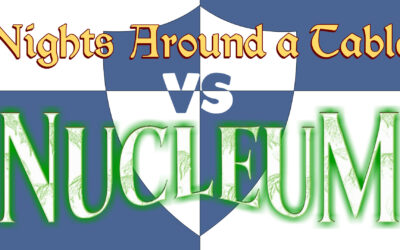The “Dungeons & Dragons” subheading on the Lords of Waterdeep game box is polarizing: you either love D&D and are jazzed to see anything under that moniker, or you feel that D&D is a strictly nerds-only brand that’s nestled a bit too deep in geekdom to draw your interest. While Lords of Waterdeep is set in the D&D Forgotten Realms domain (and benefits from all of the rich world-building and design that has gone into it in years past), this is a board game that has an entirely different style of play than a D&D roleplaying game. Dig it:
Hi! It’s Ryan from Nights Around a Table, and this is Lords of Waterdeep, a worker placement game for 2-5 players set in a fictional city from the Dungeons & Dragons universe. But! This isn’t a Dungeons & Dragons role-playing game, where you’re chucking dice and defeating monsters. You don’t have to know or understand anything about Dungeons & Dragons to enjoy or appreciate this game. So… let me show you how to play!
You and your friends play members of a shadowy secret government that pulls the strings in the fictional city of Waterdeep, where you’ll send your agents to rally adventurers to complete quests both noble and naughty.
Everyone picks a colour, which represents a faction with a cool name: the Red Sashes, the Silverstars, KC and the Sunshine Band, and so on. You take the agent pieces that match your colour – the number of agents changes based on how many people are playing – and you grab your player mat.
Each of you is dealt a secret role card with a different Lord of Waterdeep on it. The Lords all have certain predilections; most of the time, they’ll favour two types of quests. For example, Mirt the Moneylender gets more points for completing Commerce and Piety quests.
The quests come in five different flavours: Commerce and Piety (which we just saw), as well as Arcana, Warfare, and Skullduggery. You’ll get two of these Quest cards to start the game. The top part of the quest shows the cost to complete it, while the bottom shows the reward you’ll get. These differently coloured cubes represent Adventurers, which are a weird type of human currency in the game: clerics, fighters, mages, and rogues. So if you want to Expose Red Wizards’ Spies, you’ll need to send 1 cleric, 1 fighter, 2 rogues, 2 mages, and pay 2 gold, in order to get 20 victory points and 1 Intrigue card.
In order to drum up the adventurers you need to complete your quests, you have to send your agents to the different buildings in Waterdeep. Place an agent here, and you get two fighters. Place an agent here, and you get a mage.
The adventurers you recruit go here on the Tavern in your player mat.After 8 rounds of play, whoever has the most victory points wins!
When you set up the game, new quests go here, and a stack of Intrigue cards goes here. In addition to your two starting Quests, each player also gets dealt two of these Intrigue cards, which should be kept secret. The starting player is the last person to visit a city. Everyone gets 4 gold, plus another gold for each seat to the left of the starting player they’re sitting in, since going first is a big advantage.
3 building tiles get dealt here. These buildings represent extra places for your Agents to go once they’re built. 3 victory point tokens get stacked on each one of these round spaces. Off the top of every round, pepper them across the buildings, to make the buildings more attractive to purchase.
On your turn, you place one of your agents in an unoccupied building (as long as it’s been constructed), and reap the benefit. The buildings are largely self-explanatory: you get the Adventurers or money depicted for placing your agents on these ones. As long as you have agents to place, you have to place an agent on your turn. You can’t pass… unless there’s absolutely nowhere you can place an agent, which probably ain’t gonna happen.
Placing an agent on Castle Waterdeep lets you draw an Intrigue card and take (or hang onto) the first player token for the next round.
You have three options at Cliffwatch Inn: take a face-up Quest card and two gold, or a face-up Quest card and a face-down Intrigue card, or sweep all the Quest cards, deal four new ones, and take one of those. You can place more than one of your Agents at Cliffwatch Inn as long as there are spaces free, but the one-agent-per-turn rule still stands.
If you place your agent at the Builder’s Hall, you can buy one of the face-up buildings. Pay the cost, and put the building in one of the empty slots at the side of the board. Tag it with one of your faction’s markers so everyone knows you own it, and deal a new building into the gap. You’ve just created a new spot where players can play their agents. If an opponent places an agent on your building, you get the benefit listed at the bottom of the building. But you don’t get that benefit for placing your agent on your own building. Of course, you get to score any of the victory point chits that may have piled up on a building when you buy it.
The Waterdeep Harbour spaces work a little differently than the rest. As long as you have an Intrigue card to play, you can place an agent here and… play one of your Intrigue cards. We’ll take a look at Intrigue cards in just a moment. And just like Cliffwatch Inn, the Harbour can accommodate more than one agent of the same colour.
Once everyone is out of agents to assign, the agents in Waterdeep Harbour get reassigned to other unoccupied buildings by the Lords who control them, going from space 1 to space 3. So these are, like, Go-Again spaces. The agents can’t be reassigned back to the Harbour. That’s like wishing for more wishes, and believe me: genies hate that.
The Intrigue cards do all kinds of awful things, from letting you steal adventurer cubes from your opponents, to getting you extra stuff, to saddling someone with a garbage mandatory quest card that has to be completed before any other quests. WHY i OUGHTA…(drawing sword) Finished Intrigue cards wind up in this discard pile.
After you’ve placed one agent on your turn, you can optionally complete 1 quest. Pay the cost on the card, and then place it face down here, or face-up here if it’s a Plot Quest that gives you a special ability. Completing a quest on your turn is completely optional: if you have all the adventurers and gold you need to complete a certain quest, you can just sit on them until the time is right, or use them to complete another quest later. You don’t lose any points for incomplete quests at the end of the game.
At the end of the round, take all of your agents back. Sow the next round’s VP chits to the buildings. Whoever began with the first player token stays the first player, unless someone else took the token away by placing an agent in Castle Waterdeep or by playing a certain Intrigue card. You begin the game with a certain number of agents depending on how many people are playing: a 2-player game gets you 4 agents. A 3-player game gets you 3 agents. And 4- and 5-player games give you only 2 agents to work with. Regardless of the number of players, when you reach round 5, everyone unlocks an extra agent from this track. Play through all 8 rounds to finish the game.
At the end of the game, every two leftover coins get you 1 victory point, rounded down. Each Adventurer who didn’t get sent on a quest is worth 1 victory point, and then reveal your secret Lord card, which gives you victory point bonuses depending on the types of quests you completed… or the number of buildings you constructed if you’re playing Tori Amos. The player with the most VPs wins, and gold breaks ties.
The rulebook has a great index of all the Buildings, and a few rules clarifications if things get sticky.
And now you’re ready to recede into the shadows as a skeevy, cryptocratic puppetmaster in Lords of Waterdeep!
Did you just watch that whole thing? Oh – hey! To 100% this video, click the badge to subscribe, and then click the bell to get notifications when i’ve got new stuff!
Get Your Own Copy of Lords of Waterdeep: A Dungeons & Dragons Board Game
Few games in our collection are simple enough to teach quickly, yet rich enough to stand up to multiple plays. Lords of Waterdeep is an absolute gem of a game, and it gets even better when paired with its expansion, Scoundrels of Skullport. If you only own one board game for the rest of your life, you could do worse than to choose this one. If you shop for your own copy of Lords of Waterdeep using this Amazon link, we’ll earn a small commission.










Trackbacks/Pingbacks